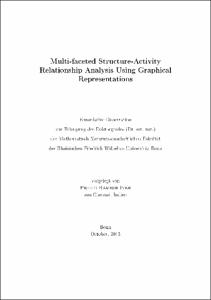Multi-faceted Structure-Activity Relationship Analysis Using Graphical Representations

Multi-faceted Structure-Activity Relationship Analysis Using Graphical Representations

| dc.contributor.advisor | Bajorath, Jürgen | |
| dc.contributor.author | Iyer, Preeti Ramesh | |
| dc.date.accessioned | 2020-04-19T19:05:30Z | |
| dc.date.available | 2020-04-19T19:05:30Z | |
| dc.date.issued | 18.02.2014 | |
| dc.identifier.uri | https://hdl.handle.net/20.500.11811/6032 | |
| dc.description.abstract | A core focus in medicinal chemistry is the interpretation of structure-activity relationships (SARs) of small molecules. SAR analysis is typically carried out on a case-by-case basis for compound sets that share activity against a given target. Although SAR investigations are not a priori dependent on computational approaches, limitations imposed by steady rise in activity information have necessitated the use of such methodologies. Moreover, understanding SARs in multi-target space is extremely difficult. Conceptually different computational approaches are reported in this thesis for graphical SAR analysis in single- as well as multi-target space. Activity landscape models are often used to describe the underlying SAR characteristics of compound sets. Theoretical activity landscapes that are reminiscent of topological maps intuitively represent distributions of pair-wise similarity and potency difference information as three-dimensional surfaces. These models provide easy access to identification of various SAR features. Therefore, such landscapes for actual data sets are generated and compared with graph-based representations. Existing graphical data structures are adapted to include mechanism of action information for receptor ligands to facilitate simultaneous SAR and mechanism-related analyses with the objective of identifying structural modifications responsible for switching molecular mechanisms of action. Typically, SAR analysis focuses on systematic pair-wise relationships of compound similarity and potency differences. Therefore, an approach is reported to calculate SAR feature probabilities on the basis of these pair-wise relationships for individual compounds in a ligand set. The consequent expansion of feature categories improves the analysis of local SAR environments. Graphical representations are designed to avoid a dependence on preconceived SAR models. Such representations are suitable for systematic large-scale SAR exploration. Methods for the navigation of SARs in multi-target space using simple and interpretable data structures are introduced. In summary, multi-faceted SAR analysis aided by computational means forms the primary objective of this dissertation. | |
| dc.language.iso | eng | |
| dc.rights | In Copyright | |
| dc.rights.uri | http://rightsstatements.org/vocab/InC/1.0/ | |
| dc.subject | medicinal chemistry | |
| dc.subject | structure-activity relationship | |
| dc.subject | SAR | |
| dc.subject | activity landscapes | |
| dc.subject | graphical representations | |
| dc.subject | SAR visualization | |
| dc.subject.ddc | 500 Naturwissenschaften | |
| dc.subject.ddc | 540 Chemie | |
| dc.subject.ddc | 610 Medizin, Gesundheit | |
| dc.title | Multi-faceted Structure-Activity Relationship Analysis Using Graphical Representations | |
| dc.type | Dissertation oder Habilitation | |
| dc.publisher.name | Universitäts- und Landesbibliothek Bonn | |
| dc.publisher.location | Bonn | |
| dc.rights.accessRights | openAccess | |
| dc.identifier.urn | https://nbn-resolving.org/urn:nbn:de:hbz:5n-35054 | |
| ulbbn.pubtype | Erstveröffentlichung | |
| ulbbnediss.affiliation.name | Rheinische Friedrich-Wilhelms-Universität Bonn | |
| ulbbnediss.affiliation.location | Bonn | |
| ulbbnediss.thesis.level | Dissertation | |
| ulbbnediss.dissID | 3505 | |
| ulbbnediss.date.accepted | 16.01.2014 | |
| ulbbnediss.fakultaet | Mathematisch-Naturwissenschaftliche Fakultät | |
| dc.contributor.coReferee | Gütschow, Michael |
Dateien zu dieser Ressource
Das Dokument erscheint in:
-
E-Dissertationen (4116)




